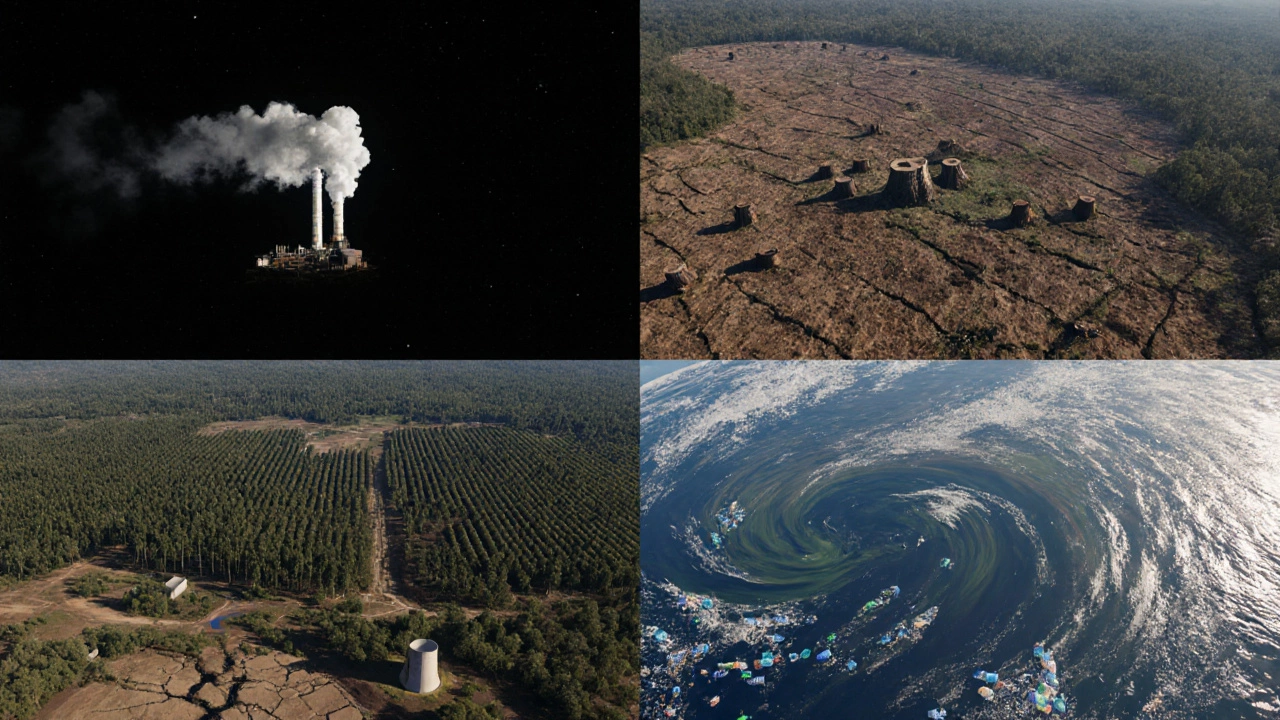Personal Carbon Footprint Calculator
Your Carbon Footprint
Your estimated annual carbon footprint is tons of CO₂ equivalent.
The global average is 4.8 tons of CO₂ per person annually. The article states that fossil fuel combustion accounts for 75% of environmental impact, which directly relates to your energy and transportation choices.
How This Compares
Recommended Actions
- Switch to renewable energy sources where possible
- Reduce car usage by 20% (replacing with public transport, biking, or walking)
- Follow "Meatless Monday" to reduce meat consumption
- Refuse single-use plastics and carry reusable alternatives
- Support reforestation initiatives in your community
When you hear headlines about the planet in trouble, it’s easy to feel overwhelmed. But if you zero in on the data, a clearer picture emerges: a handful of activities are responsible for the lion’s share of our planet’s damage. Knowing exactly which forces top the list lets you focus energy where it matters most.
Key Takeaways
- Fossil‑fuel combustion accounts for roughly 75% of total human‑induced environmental impact.
- Deforestation, industrial agriculture, and plastic pollution together contribute another 20%.
- Each driver harms the Earth in distinct ways-climate warming, biodiversity loss, pollution of land and water.
- Mitigation starts with cutting emissions, protecting forests, and reducing single‑use plastics.
- A simple checklist at the end helps you prioritize personal and community actions.
Earth is a complex, life‑supporting system that responds to human pressures through climate shifts, habitat loss, and pollution. Understanding which pressures are most destructive is the first step toward stopping them.
Why the Question Matters
Environmental groups spend millions on campaigns, but funding and volunteer time are limited. Directing resources toward the biggest drivers of harm maximizes impact. This article breaks down the top culprits, shows how they interlink, and gives you concrete steps to fight back.
The Heavyweights of Environmental Damage
Scientists use a suite of metrics-carbon dioxide equivalents, land‑use change, ecosystem services loss-to rank human activities. The consensus from the Intergovernmental Panel on Climate Change (IPCC), the Food and Agriculture Organization (FAO), and peer‑reviewed life‑cycle assessments points to four primary offenders.
Fossil fuel combustion
Burning coal, oil, and natural gas for energy releases about 33 gigatons of CO₂ each year, dwarfing all other sources. The heat trapped by these gases drives global temperature rise, amplifies extreme weather, and acidifies oceans. In addition to CO₂, combustion emits sulfur dioxide, nitrogen oxides, and black carbon-all of which impair air quality and human health.
Deforestation
Every year, roughly 10 million hectares of forest vanish-mostly in the Amazon, Congo Basin, and Southeast Asia. Trees act as carbon sinks; cutting them releases stored CO₂ and reduces the planet’s capacity to absorb future emissions. Forest loss also destroys habitats, pushes countless species toward extinction, and disrupts rainfall patterns.
Industrial agriculture
Large‑scale crop and livestock production supplies the world’s food but at a steep ecological price. Synthetic fertilizers emit nitrous oxide-about 300 times more potent than CO₂ per molecule. Livestock, especially cattle, generate methane during digestion, while intensive animal farms contaminate waterways with runoff.
Plastic pollution
More than 380 million tons of plastic are produced annually; roughly 8 million tons enter oceans each year. Plastics linger for centuries, breaking into micro‑particles that infiltrate marine food webs, harm wildlife, and even end up in human bloodstreams.

How These Drivers Stack Up
| Rank | Driver | Share of total impact | Main environmental effect |
|---|---|---|---|
| 1 | Fossil fuel combustion | ≈75% | Global warming, air pollution |
| 2 | Deforestation | ≈10% | Carbon release, habitat loss |
| 3 | Industrial agriculture | ≈8% | GHG emissions, water contamination |
| 4 | Plastic pollution | ≈5% | Marine ecosystem damage, micro‑plastic spread |
These numbers are not static; they shift with policy, technology, and consumer behavior. Yet the ranking gives a quick visual of where the biggest levers lie.
Beyond the Top Four: Other Notable Threats
Two additional factors often slip under the radar but compound the damage caused by the main drivers.
Methane emissions
While livestock are part of industrial agriculture, methane leaks from natural gas pipelines and landfill sites add another ~2Gt CO₂e annually. Methane’s short‑lived but intense warming potential makes rapid mitigation essential.
Water scarcity
Over‑extraction for irrigation, industry, and urban use depletes aquifers faster than recharge. Freshwater scarcity stresses ecosystems, reduces food production, and fuels conflict in vulnerable regions.
Biodiversity loss
The combined effect of habitat destruction, pollution, and climate change threatens an estimated 1million species with extinction. Loss of biodiversity undermines ecosystem services like pollination, carbon storage, and disease regulation.
Pathways to Reduce the Biggest Impacts
Knowing the key contributors lets you target actions with the highest return on effort. Below are evidence‑based strategies that individuals, communities, and policymakers can adopt.
Cut Fossil‑Fuel Use
- Switch to renewable electricity (solar, wind, hydro) whenever possible. In 2024, renewables supplied 32% of global electricity-a number that’s rising fast.
- Choose public transport, bike, or walk for short trips. A 2023 study showed that replacing 20% of car journeys with transit cuts per‑capita CO₂ by 0.5t/year.
- Support policies that price carbon or phase out coal‑fired plants. Countries with carbon taxes have seen emissions drop by an average of 7% within five years.
Protect and Restore Forests
- Back initiatives that halt illegal logging. Satellite monitoring now detects 95% of unauthorized clear‑cutting within days.
- Participate in or fund re‑forestation projects that use native species. Restored forest areas can sequester up to 10t CO₂ per hectare per year.
- Advocate for land‑use policies that give Indigenous groups stewardship rights-research shows such lands have the lowest deforestation rates.
Transform Food Systems
- Reduce meat consumption, especially beef. A 2022 life‑cycle analysis found that swapping one beef meal per week for plant‑based alternatives cuts an individual’s carbon footprint by ~0.3t CO₂e annually.
- Buy locally produced, seasonal produce to cut transportation emissions.
- Support regenerative agriculture practices-cover cropping, reduced tillage, and diversified rotations-that can draw down carbon and improve soil health.
Eliminate Unnecessary Plastics
- Refuse single‑use items (straws, bags, cutlery). If every person in the U.S. avoided one plastic bag per week, 5million tons of waste would be avoided each year.
- Switch to reusable containers and bottles.
- Promote extended producer responsibility (EPR) laws that make manufacturers fund collection and recycling.
Address Methane, Water, and Biodiversity
- Fix leaks in natural‑gas infrastructure; the U.S. EPA estimates that leak repairs could cut methane emissions by 40%.
- Implement water‑saving irrigation (drip systems) that reduce usage by up to 60% compared with flood irrigation.
- Create wildlife corridors that reconnect fragmented habitats, helping species adapt to climate shifts.

Quick Action Checklist
- Audit your home’s energy use and switch to renewable providers.
- Replace at least one car trip per week with biking, walking, or public transport.
- Commit to a “Meat‑less Monday” or similar regular plant‑based day.
- Carry a reusable bag, bottle, and cutlery; refuse single‑use plastics.
- Donate time or money to a local re‑forestation or habitat‑restoration group.
- Support political candidates with strong climate and conservation platforms.
What the Data Means for Environmental Groups
For NGOs, the takeaway is clear: prioritize campaigns that cut fossil‑fuel emissions, protect forests, and reshape food systems. Funding models that bundle climate mitigation with biodiversity preservation tend to achieve the greatest multiplier effects. Moreover, community‑level education on plastic reduction and water stewardship builds public buy‑in for larger policy changes.
By focusing on the highest‑impact drivers, groups can stretch limited resources, rally volunteers around tangible goals, and demonstrate measurable progress to donors.
Looking Ahead
Technological advances-like green hydrogen, carbon capture, and biodegradable polymers-promise new ways to lower the yearly damage tally. However, the speed of adoption will dictate whether we stay within safe planetary boundaries. Keeping a finger on the biggest current threats ensures we don’t lose sight of the most urgent battles.
Frequently Asked Questions
Which activity contributes the most to global warming?
Burning fossil fuels for electricity, heat, and transport is responsible for about three‑quarters of human‑induced greenhouse‑gas emissions, making it the single largest driver of climate change.
How does deforestation affect climate?
When trees are cut, they release the carbon stored in their trunks and soils. Forests also lose the ability to absorb CO₂, amplifying atmospheric concentrations and warming.
Can individual dietary changes really lower emissions?
Yes. Shifting just one meal a week from beef to a plant‑based option can shave roughly 0.3t of CO₂e from a typical adult’s yearly footprint, according to multiple life‑cycle studies.
What are effective ways to reduce plastic waste at home?
Start by refusing single‑use items, swapping to reusable containers, and buying products with minimal packaging. Joining local clean‑up events amplifies impact by diverting waste before it reaches waterways.
Why is biodiversity loss considered an environmental destroyer?
Biodiversity underpins ecosystem services-pollination, water purification, carbon storage. Losing species weakens these natural buffers, making ecosystems less resilient to climate shocks.






